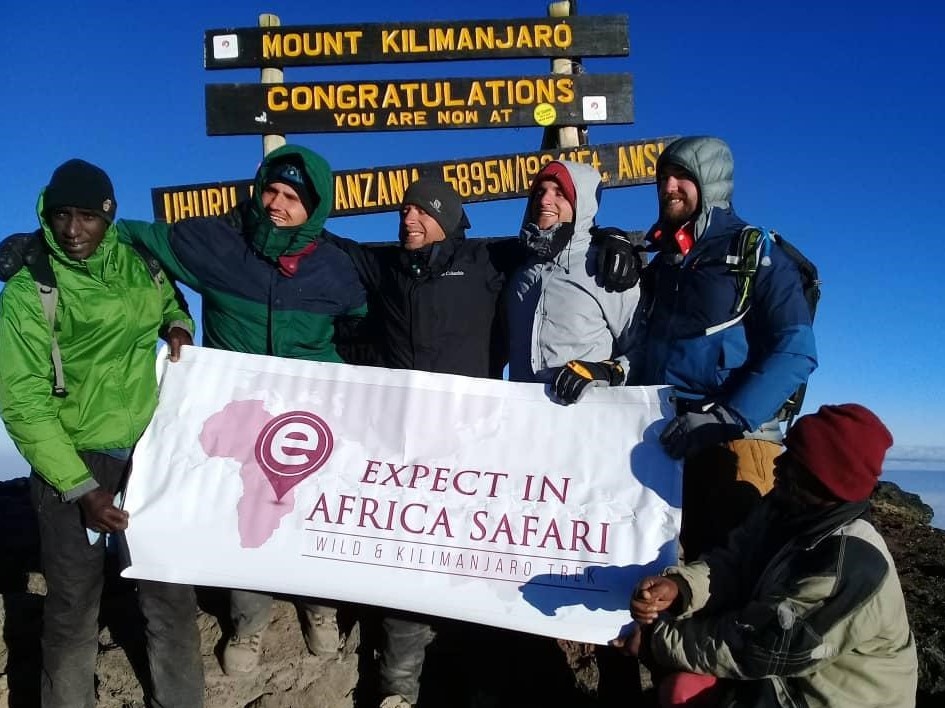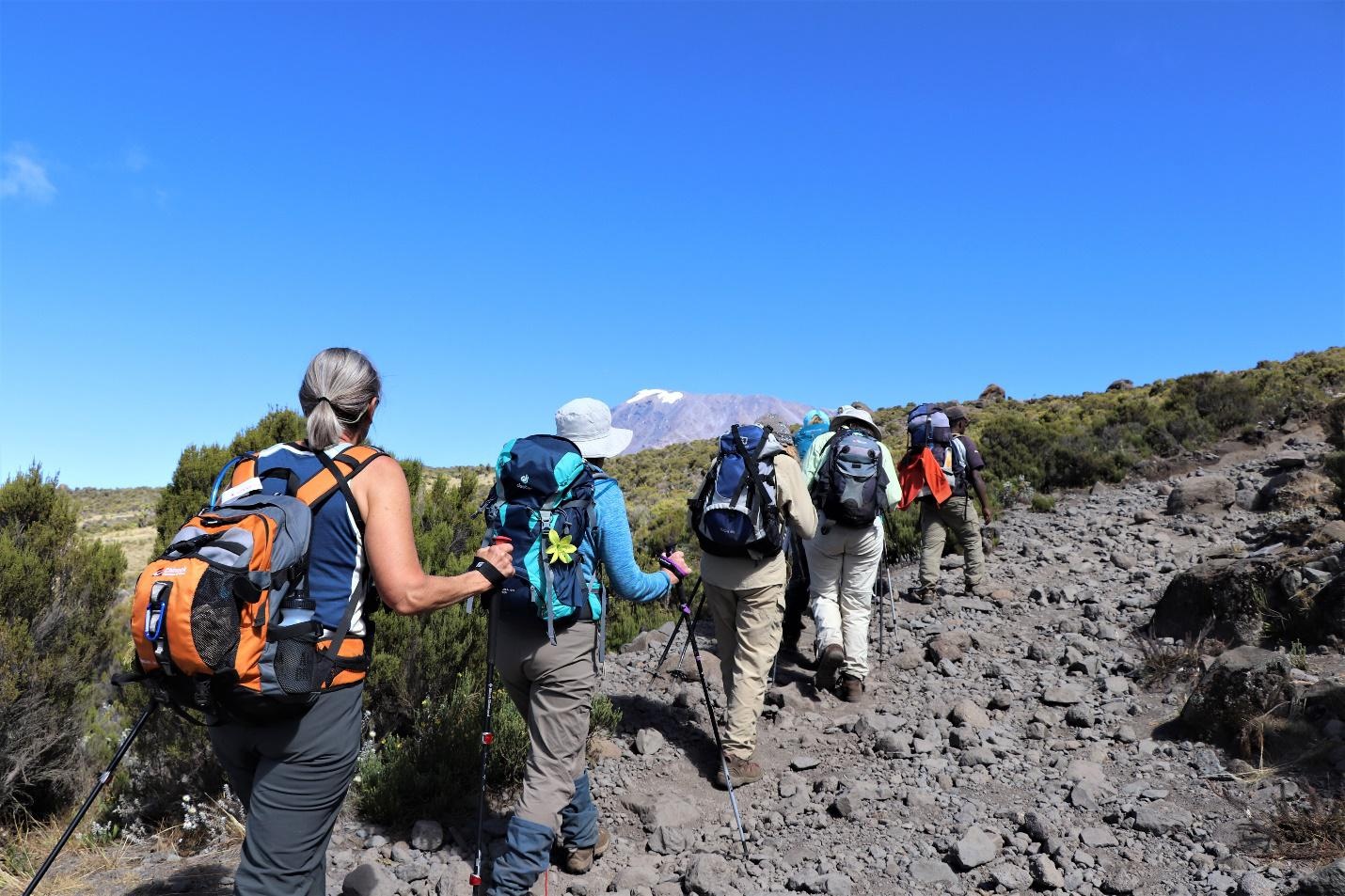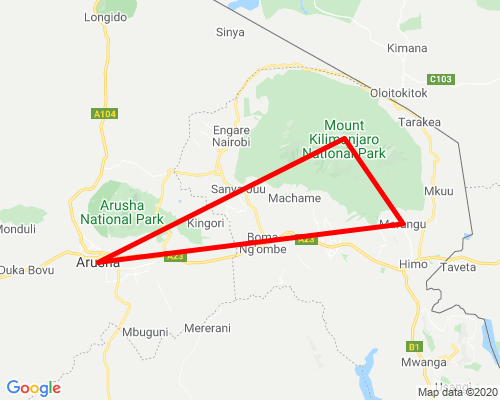Mount Kilimanjaro~Marangu Route
Mount Kilimanjaro~Marangu Route
43 Views
Mount Kilimanjaro~Marangu Route
8 Days Starting and ending in Arusha
Visiting: Arusha, Marangu, Mount Kilimanjaro, Mount Kilimanjaro
Tour operator:
Recommended For:
Guide Type:
Fully Guided
Group size:
2 - 10
Physical rating:
High
Age range:
18-60
Special diets catered:
Vegetarians, Vegans
Tour operated in:
EnglishTrip Styles:
Tour Overview
The Marangu route, also known as the "Coca-Cola" route, is the oldest, most well established route on Kilimanjaro. This is the only route which offers sleeping huts in dormitory style accommodations in lieu of camping. There are 60 bunk beds each at Mandara and Kibo Huts, and 120 bunk beds at Horombo Hut. Guests are supplied with mattresses and pillows, but sleeping bags are still required. The huts have communal dining halls and basic washrooms, ranging from flushing toilets and running water at the lower huts to long drop toilets and buckets of water at Kibo Hut.
Highlights
Itinerary
Day 1 : Welcome To Tanzania
Location: Arusha
Accommodation: Hotel, Arumeru River Lodge
Meals Included: Lunch, Dinner
You will be picked up by the staff of Expect In Africa Safari from Kilimanjaro International Airport (JRO) and driven to your accommodation in Arusha. Participants will be given a short briefing for the climb the next day. Kits and the necessary equipment will be checked as well.
Day 2 : Hotel To Marangu Gate To Mandara Hut
Location: Marangu
Accommodation: Mandara Hut
Meals Included: Breakfast, Lunch, Dinner
After an early breakfast we will leave Arusha at 8:30am, drive for approximately 50 minutes to Kilimanjaro’s Marangu Gate on the eastern side of the mountain. Your guide will handle your registration before we begin the hike around 10:30am.
We start off in the rainforest – enjoy the towering Eucalyptus trees, bird life, and Colubus monkeys. At these lower elevations, it can be wet and muddy, so gaiters and trekking poles will help. Shorts and t-shirts should be sufficient, but keep your rain gear and warmer clothing handy. We will stop at the halfway mark for lunch, and reach the Mandara Hutsat 2 or 3pm. Unpack, rest, and have some tea or coffee. A 15 minute side trip to Maundi Crater is a good way to see the surroundings including Northern Tanzania and Kenya. Dinner is served during the early evening at 7pm. Bathrooms with running water are available.
Marangu Gate to Mandara Huts
Elevation: 1860m to 2715m
Distance: 8 km
Hiking Time: 4-5 hours
Habitat: Montane Forest
Day 3 : Mandara Hut To Horombo Hut
Location: Mount Kilimanjaro
Accommodation: Mandara Hut
Meals Included: Breakfast, Lunch, Dinner
Today we will have a fairly leisurely wake up in time for a 7:30am breakfast. We’ll aim to break camp by 8:30am and hike for an hour through rainforest glades. We will then follow an ascending path through heathland where we’ll be able to look for giant lobelias and groundsels. We continue up into open moorlands where small shrubs comprise the majority of vegetation. Again we’ll stop halfway for lunch, where we will enjoy amazing views of Mawenzi, if the weather is clear. We should arrive at the Horombo Huts by 4pm, where Kibo summit is visible on clear days. Rest, unpack, and prepare for dinner. Bathrooms with running water are available.
Mandara Huts to Horombo Huts
Elevation: 2715m to 3705m
Distance: 11.5 km
Hiking Time: 6-8 hours
Habitat: Heathland and moorland
Day 4 : Acclimatization Day
Location: Mount Kilimanjaro
Accommodation: Mandara Hut
Meals Included: Breakfast, Lunch, Dinner
Acclimatization Day - Horombo Hut is a village of huts perched on a small plateau, with a total capacity of 120 climbers. Horombo is normally bustling with hikers, guides and porters, with an atmosphere of adventure and excitement. You will meet both ascending and descending hikers here. This extra day and night at Horombo is for additional acclimatization. A hike to basecamp below Kibo’s sub peak Mawenzi, passing the Zebra Rocks on the way (around 3 hours up and 1.5 hours down), is strongly recommended. This hike will further assist with the process of acclimatization. Remember to drink enough water and move slowly!
Day 5 : Horombo Hut To Kibo Hut
Location: Mount Kilimanjaro
Accommodation: Kibo Hut
Meals Included: Breakfast, Lunch, Dinner
We will wake up for breakfast as usual – or wake up early to capture an amazing sunrise. The first part of the day’s hike climbs through the dwindling heathland that blends into what can best be described as moonscape as we enter the sweeping saddle connecting Mawenzi and Kibo. When we stop for lunch, and later when crossing this surprisingly large saddle, take in the summit climb up to Kibo that we will be starting in just a few hours. Be careful to notice any signs of altitude sickness. There is no running water at the Kibo Huts.
Horombo Huts to Kibo Huts
Elevation: 3705m to 4730m
Distance: 10 km
Hiking Time: 6-8 hours
Habitat: Alpine Desert
Day 6 : Summit Day~Kibo Hut To Uhuru - Peak To Hrombo Hut
Location: Mount Kilimanjaro
Accommodation: Camp, Horombo Hut
Meals Included: Breakfast, Lunch, Dinner
We will wake at midnight, have a light breakfast and prepare for our summit ascent. The goal is to reach Uhuru Peak around sunrise. We leave Kibo Huts at 1am, switchback up steep scree or possibly snow, and reach Gilman’s Point on the crater rim at 5861m around 4-6am. Here, views of the fabled crater and its icecaps greet us. Another 2 hours of hiking along the crater rim near the celebrated snows takes you to Kilimanjaro’s true summit, Uhuru Peak, by 6-8am. This is Africa’s highest point – we’d have to travel more than 3,000 miles toward the Himalayas to find a higher peak! Be sure to have your picture taken at the summit to show your friends. After our time on top, we descend back to the Kibo Huts, have lunch and rest a while. We will then collect our things and cross the saddle and head back to the Horombo Huts. After dinner, get some well-deserved sleep!
Please note that we will be doing the beginning of this climb in the dark with headlamps or flashlights. It will be very cold until you start descending, so you will need all of your warm layers. This is, by far, the most difficult part of the trek. Slowly, slowly, or, “pole, pole,” and an optimistic attitude will get you there!
Summit Day - Kibo Huts to Uhuru Peak to Horombo Huts
Elevation: 4730m to 5895m to 3705m
Distance: 5.4 km up, 15 km down
Hiking Time: 13-16 hours
Habitat: Stone scree/ice-capped summit
Day 7 : Horombo Hu To Marangu Gate & Back To Arusha
Location: Arusha
Accommodation: Hotel, Arumeru River Lodge
Meals Included: Breakfast, Lunch, Dinner
Today we descend through the moorland back to the Mandara Huts. We’ll have lunch there and continue down through lush forest to the park gate, which we should reach around 2 or 3pm. Here you will receive your certificates and we will say goodbye to our guides, cooks, and porters. We’ll transfer to your hotel in Moshi or Arusha or take you straight to the airport. Wherever you are it will definitely be a time for celebration!
Horombo Huts to Marangu Gate
Elevation: 3705m to 1860m
Distance: 19 km
Hiking Time: 6-7 hours
Day 8 : Fly Back Home
Location: Arusha
Meals Included: Breakfast, Lunch
After breakfast, we can arrange for a private transfer or taxi to Kilimanjaro International Airport (JRO). Drive time : 1 hour
What's Included
-
Park fees
-
All Taxes/VAT
-
Drinking water on all days
-
Round-trip airport transfer
-
All activities (unless labeled as optional)
-
All transportation (unless labeled as optional)
-
Airport transfers from Kilimanjaro airport and all road transportation from start to finish of the trip
-
6 day Marangu Route Kilimanjaro climb (including meals & drinking water, camping accommodation, services of guide, porters and cook)
What's Not Included
-
Train Tickets
-
Tipping and Gratuities
-
International Travel
-
Country Entry Visas
Check out our Q&As
-
Trekking Parking List
Base, Middle and Outer Layers The principle of layering is key here so that you can easily manage your body temperature simply by adding or removing layers. Base Layers – The base layer is the first layer of clothing you put on and it ideally functions to maintain your body temperature and keep you dry. Fabrics such as merino wool or Capilene which work to wick moisture away from your body are the best. Cotton tends to absorb moisture and hampers your ability to regulate temperature. Moisture wicking long sleeve tee-shirts (2) Moisture wicking tee-shirts (2) Long underwear pants (2) Underwear (3 to 5) Middle Layers – The middle layer serve to insulate the body from the cold. The best materials for insulating layers in very cold conditions are down and wool otherwise a fleece jacket can make a good insulating layer. It’s preferable to have middle layers with zippers so you can easily zip or unzip to regulate temperature rather than having to remove layers entir>ly. Heavy Fleece or Down Jacket Long sleeve shirts (2) Sweatshirt (optional) Fleece Pants Trekking Pants (2) Shorts (optional) Shell or Outer Layer – The shell or outer layer is designed to protect you from the wind and keep you dry. Gortex which is both waterproof and breathable is the ideal fabric for this. Nylon is a cheaper alternative and provides protection but is not breathable so can trap moisture in which you don’t want. Gortex or Waterproof Jacket with hood Rain Poncho Waterproof Pants Hats, Gloves and Gaiters Hats – While it’s still warm on the first few days of the trek a wide brimmed hat that offers sun protection is the best. When it’s cold a wool and/or Balaclava is the best option. Gloves – A light weight glove is good for most early morning and evening on the way up and can be combined with a wool or down mitten for the cold conditions on the summit. Gaiters – While it’s unlikely you will be hiking through snow gaiters can help keep your socks dry when it’s wet and protect your skin from the dust when it’s dry. Wide brimmed hat Wool hat (Should cover ears) Balaclava or Ski Mask Lightweight Glove Insulated Wool or Down Mitten Footwear: Shoes and Socks Shoes – Choice of footwear probably varies to some degree on personal preference. Tennis shoes are suitable until base camp although some may prefer hiking shoes. A pair of sturdy hiking shoes is needed on the summit day to provide ankle support on the steep slopes with loose rocks and to keep your feet warm. Make sure that your hiking shoes have extra room for socks and are not too tight fitting. We recommend breaking in your hiking boots before you come and not to bring a new pair. Socks – Wool socks provide the most insulation and keep your feet warm. Sock liners are lightweight socks made of a material like Capilene that wicks moisture from the skin. If you are susceptible to getting blisters they can be useful in preventing abrasion between your outer-sock and skin. Hiking boots with ankle support Camp shoes or Tennis Shoes Plastic bag to carry spare shoes Hiking socks (5) Sock Liners (optional) Sleeping Bag If you are on the Marangu Route you will not need a sleeping (pad) as they are provided in the huts along with sheets. But you will need following stuff Sleeping bag rated to 15° C/ 0° f Sleeping bag liner (optional) Sleeping bag stuff sack Duffel Bags and Day Packs Most of your gear will be carried during the day by your porters. You should have a high quality duffel bag that you can place everything except what you need on the trail into. If it’s raining a lot your duffel bag might get wet on the way up the mountain so consider a waterproof one or packing your belongings in several dry bags inside the duffel. Duffel Bag for Carrying Your Gear Day Pack for Carrying what you need on the trail Waterproof cover for daypack Dry bags in several sizes Stuff sacks for dirty clothes/shoes On the Trail He’re are some items you will to keep easily accessible while you are on the trail Sunscreen Lip Balm with Sunscreen Iodine Water Tablets Water Bottles or Camel Back Sunglasses Headlamp with extra batteries Plastic bags for garbage High Energy Snacks Waterproof bags to protect electronics or paperwork Camera with extra batteries and memory cards Umbrella (works great in a light rain or to protect from the sun) (but important ) Toilet Paper Trekking Poles for summit day First Aid Kit and Toiletries Our team brings along a basic first aid kit but we recommend you also carry the following; Advil or Ibuprofen Diamox (for altitude sickness) Personal Prescriptions Medical Tape (for preventing treating blisters) Antibiotics (Cipro for travelers’ diarrhea) Diaper Rash Cream (Can treat rashes or chaffing) Basic toiletries (Soap, Deodorant…) Wet wipes Panty Liners and Tampons Face lotion Hair brush Hair ties Hand warmers Paperwork and Money Passport (needed at entry gate for registration) Money for tips at end of trek
Book with Confidence
-
Low Deposit
Expect In Africa Safari requires a minimum deposit of 0% or the full booking value, whichever is less, with the final balance not due until 30 days before departure.
Why book with tourhub?
Safe & Secure
Your money is protected in an external trust until you travel.
100% Guaranteed Refunds if your trip is cancelled.
The safest way to make overseas, multi-currency payments.
Guaranteed Best Value
Industry leading discounts, we won't be beaten on price.
No cancellation or amendment fees from tourhub.
(Operator terms may apply)
Expert Knowledge
Reliable & unbiased advice from travel experts.
Direct contact with the tour operator via our messaging service.
Inspiration & advice from a community of 6000+ real travellers, influencers & content creators.
Trusted Service
Official partners & licensed agents of 1000+ tour operators worldwide.
Don't just take our word for it...
"Tourhub: Friendliness, Professionalism & Integrity I would happily give tourhub a 6* review if I could..."





